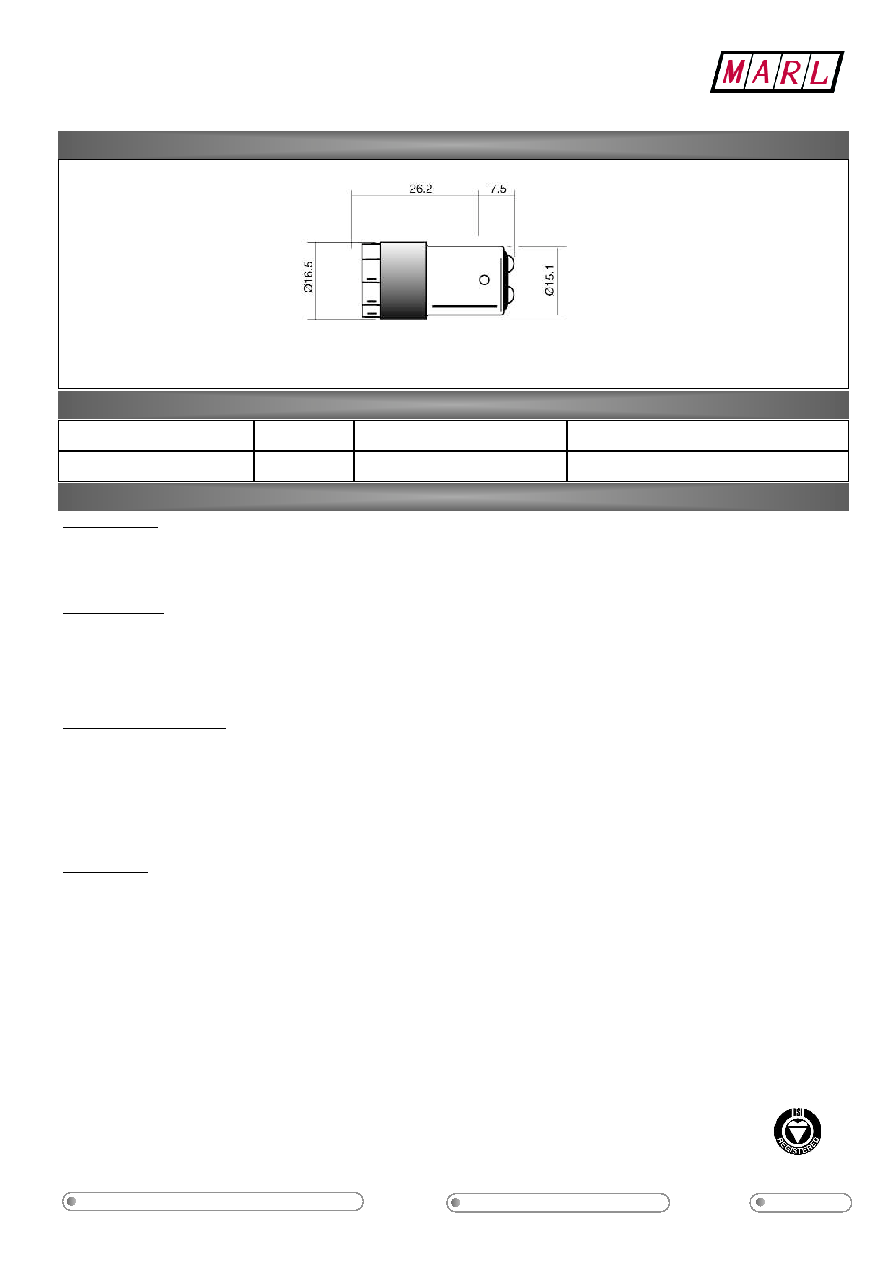- 您現(xiàn)在的位置:買賣IC網(wǎng) > PDF目錄153873 > 225-993-24-38 (MARL INTERNATIONAL LTD) SINGLE COLOR DISPLAY CLUSTER, WARM WHITE PDF資料下載
參數(shù)資料
| 型號: | 225-993-24-38 |
| 廠商: | MARL INTERNATIONAL LTD |
| 元件分類: | 顯示用LED |
| 英文描述: | SINGLE COLOR DISPLAY CLUSTER, WARM WHITE |
| 封裝: | ROHS COMPLIANT PACKAGE-1 |
| 文件頁數(shù): | 2/2頁 |
| 文件大小: | 120K |
| 代理商: | 225-993-24-38 |

225 Series
BS EN ISO 9001:2000
Approved Manufacturer
SAMPLES AVAILABLE
MARL INTERNATIONAL LTD 2007 : DS 007/07 Issue 1
Page 2 of 2
website: www.marl.co.uk email: sales@marl.co.uk
Telephone +44 (0)1229 582430 Fax: +44 (0)1229 585155
The information contained in this datasheet does not constitute part of any order or contract and should not be regarded as a representation
relating to either products or service. Marl International reserve the right to alter without notice the specification or any conditions of supply
for products or service.
Dimensions in mm (Typical)
Not to scale
+ Printed on base denotes Anode. Colour dot on
product denotes LED colour
TECHNICAL INFORMATION
Lamp Base Style
Series
Metric Equivalent (mm)
Maximum Power Dissipation (mW)
Ba15d Filament Base
225
15
225
DESIGN CONSIDERATIONS
Single-Chip LEDs
All devices feature water clear high intensity LEDs as standard. The single chip LED devices have been modified by the removal of the domed
portion of the encapsulation (flat-topped) to provide even illumination of switches and annunciators. Non flat topped versions are also available,
please contact the sales department for details.
Product Evaluation
Filament Replacement LEDs have been specifically designed to meet the primary objective of providing improved reliability. As this product range
is suitable for both new-build and retro-fit, (sometimes in very old systems), a wide range of illuminated push button switches and lamp holders
can be encountered. Due to subjectivity, evaluation of the LED type is recommended, (samples of all standard models are available). Care should
be taken to correctly simulate operating ambient light conditions to ensure that the correct device has been selected to maximise viewing
characteristics such as viewing angle, colour compatibility and on/off contrast ratio.
Electro-static Discharge (ESD)
Build up of electro-static discharge occurs in many situations involving people moving and handling products. The range of possible situations is
very diverse but voltage levels as high as several thousand volts can and do arise in many individual situations. When an operator charged up to
these levels handles a ‘static sensitive device’, there is a very probable likelihood that the device will be irreversibly damaged. It is essential that
precautions are taken at all stages during manufacture and assembly of these products. Although LEDs were never considered to be static
sensitive devices, changes in manufacturing technology and materials used to produce higher intensity products over a large range of the
wavelength spectrum have changed this. Marl has an approved system of ESD control from goods in, through production and into final packing
and despatch. We recommend all users of LED based products follow the guidelines of BS 100015.
Power de-rating
The forward voltage/current value of an LED is dependant upon the ambient temperature of the environment in which it is operated. Therefore,
care must be taken to operate the LED at the correct voltage/current values, depending upon the ambient temperature. Consequently, a
recommendation regarding operating voltages and currents is given in order to address these temperature effects. This recommendation is
termed ‘de-rating’.
It is usual for forward voltages and currents to be specified for ambient temperature of 25°C. However, because the values of these qualities vary
with temperature, Marl should be contacted if the device is to be operated at a temperature significantly higher than 25°C.
Marl accept no liability for any product that is operated higher than the stated voltage.
Note:
All luminous intensity figures refer to the unmodified discrete LED.
相關(guān)PDF資料 |
PDF描述 |
|---|---|
| 225000 | 154 CONTACT(S), MALE, STRAIGHT TWO PART BOARD CONNECTOR, PRESS FIT |
| 225002 | 154 CONTACT(S), MALE, STRAIGHT TWO PART BOARD CONNECTOR, PRESS FIT |
| 225003 | 133 CONTACT(S), MALE, STRAIGHT TWO PART BOARD CONNECTOR, PRESS FIT |
| 225006 | 200 CONTACT(S), MALE, STRAIGHT TWO PART BOARD CONNECTOR, PRESS FIT |
| 2252711019 | PROXIMITY SENSOR-PHOTOELECTRIC, RECTANGULAR, PANEL MOUNT |
相關(guān)代理商/技術(shù)參數(shù) |
參數(shù)描述 |
|---|---|
| 225-997-21 | 制造商:MARL International Limited 功能描述:LED RPL BULB CW 16.5MM BA15D |
| 225-997-22 | 制造商:MARL International Limited 功能描述:LED BA15D 24V WHITE 制造商:MARL 功能描述:LED, BA15D, 24V, WHITE |
| 225-997-22 | 制造商:MARL International Limited 功能描述:LED BA15D 24V WHITE |
| 225-997-23 | 制造商:MARL International Limited 功能描述:LED RPL BULB CW 16.5MM BA 制造商:MARL International Limited 功能描述:LED BA15D 28V WHITE |
| 225-997-23 | 制造商:MARL International Limited 功能描述:LED BA15D 28V WHITE |
發(fā)布緊急采購,3分鐘左右您將得到回復(fù)。